Top Image: Polish Home Army captures ammunition from German HQ in 1944. Courtesy of The Miriam and Ira D. Wallach Division of Art, Prints and Photographs: Photography Collection, The New York Public Library. New York Public Library Digital Collections. Accessed August 23, 2021. digitalcollections.nypl.org/items/510d47db-abea-a3d9-e040-e00a18064a99
Note from the Author
Many of the locations mentioned in this article have changed names several times over the course of the twentieth century. In order to maintain historical accuracy, I have used the names of places as they were in 1944, but have included present-day designations in parentheses to avoid confusion.
In February 1943, Stefan Rowecki, the leader of the Polish Home Army (Armia Krajowa or AK) until his arrest by the Gestapo in June 1943, drafted a plan for a national armed uprising throughout Poland called Operation Tempest. Rowecki’s plan was to unfold in three stages: an armed rising in the eastern cities of Lwow (L’viv) and Wilno (Vilnius), followed by an armed attack in the area east of the Vistula River, and, finally, a national uprising throughout the entire country.
According to General Kazimierz Sosnkowski, who was a member of the exiled Polish government in London, Operation Tempest was predicated on the notion that “the final aim of the Soviet Union [was] to transform Poland into a vassal Communist republic or simply into the 17th Soviet republic.”
Sosnkowski’s assumptions were not incorrect; Stalin had already mentally claimed Eastern Europe for himself and after the Tehran Conference in November 1943, the Allies agreed that the future eastern border of Poland would be drawn at the Curzon Line, which gave large chunks of Polish prewar territory to the Soviet Union. Consequently, the plan was to attack the Germans as they retreated westward, prevent reprisals against civilians, and, most importantly, to secure important Polish cities before the Soviets could take over.
Despite the fact that Warsaw, as the capital of Poland, was of strategic importance to the Germans, the city was purposely excluded in the original plan for Operation Tempest in order to avoid destruction to historical buildings and to prevent mass suffering of the city’s population.
For centuries, Poles and Russians had contested the 2,000 kilometers (1,200 miles) that separated the Vistula and Volga rivers. When the Tsarist Empire fell in 1917, many Eastern European national groups claimed their independence, but during the so-called Russian Civil War the Bolsheviks were able to suppress most of these newly founded states. However, Poland was one exception and, from the Soviet point of view, the Polish defeat of the Red Army in 1920 was a shameful memory since it shattered Bolshevik hopes of including Poland in a new kind of empire in Eastern Europe in the form of the Soviet Union. Therefore, as stated by the Russian historian, Sergei Kudryashov:
“prejudices against Poland were not peculiar to Stalin but were characteristic of the whole Soviet elite.”
Sergei Kudryashov
Soviet plans for the post-war Russian-Polish border can be best illustrated by a confidential memorandum written by Ivan Maisky, the Soviet Union’s ambassador to the United Kingdom, to Vyacheslav Molotov, the Soviet Minister of Foreign Affairs, on January 10, 1944. In the memorandum Maisky clearly states that Soviet intentions were to keep Poland territorially small and politically weak:
“The purpose of the USSR must be the creation of an independent and viable Poland; however, we are not interested in the appearance of too big and too strong a Poland. In the past, Poland was almost always Russia’s enemy, and no one can be sure that the future Poland would become a genuine friend of the USSR (at least during the lifetime of the rising generation). Many doubt it, and it is fair to say that there are serious grounds for such doubts.”
However, the exiled Polish government in London, which commanded the AK, did not have diplomatic relations with the Soviet Union and, therefore, was unaware of the extent to which Stalin would allow Poland to remain a sovereign nation after the war ended. While it was vitally important for the AK to assist the Red Army in liberating Poland from German occupation, the exiled Polish government also felt it necessary to demonstrate its own self-sufficiency.
As the Red Army approached the prewar Polish-Soviet border in the winter of 1943-1944, the exiled Polish government radioed instructions to begin implementing plans for the national uprising to General Tadeusz Komorowski, who had taken over command of the AK after Rowecki was arrested. Komorowski, better known by the name Bór-Komorowski (Bór, meaning “The Forest” in Polish, was one of his wartime codenames), considered several possible scenarios for action ranging from limited operations against the Germans to a full-scale war against Soviet forces when they arrived in Poland, but settled on Rowecki’s original plan for a series of uprisings in a number of localities of central importance to the Germans.
In preparation for Operation Tempest, partisan groups were assembled into larger units and directed to districts that laid across the German lines of retreat. In the eastern provinces, which were the first to start Tempest operations, all soldiers of the AK were mobilized and regiments, battalions, and divisions received names and numbers. Arms, ammunition, and other equipment such as war clothing, uniforms, coats, caps, boots, and hospital supplies, which had been manufactured in homes or in secret workshops, were smuggled to the forests. As a result, the Polish partisan groups in the east grew into a substantial regular force before the Red Army reached them.
Operation Tempest began in March 1944 when Major Wojciech “Oliwa” Kiwerski, who commanded the AK 27th Division, received orders to launch several small uprisings in the Wołyń (Volyn) province, today part of northeastern Ukraine. During January and February 1944, Kiwerski’s division had engaged the Germans using guerilla techniques and eventually gained control of small areas in and around Wołyń.
In March 1944, the 27th encountered leading units of the Red Army and cooperated with them in the capture of Kowel (Kovel) and Turzysk (Turiis’k). A German counterattack led to five days of fighting, during which Soviet troops and the AK were separated and the AK was left to fight on their own. The remnants of the division fought the Germans for another two months before AK commanders ordered them to retreat westwards across the Bug River.
Thus, the first major battle of Operation Tempest was a political and military failure despite the hopeful nature of first contacts with the Soviets. During the spring and summer of 1944, the Red Army made no further advances against the Germans. Although Soviet forces controlled the Polish provinces of Wołyń, (Volyn), Stanisławów (Ivano-Frankivsk), and Tarnopol (Termopil), they were too weak to undertake military operations to liberate any major Polish cities in the spring of 1944, and instead of working with the Polish Home Army, Soviet authorities disarmed and disbanded any AK unites they found.
During this time, Bór-Komorowski asked General Sosnkowski to approach the British government for assistance in organizing additional uprisings in Poland’s larger cities, but a national uprising in Poland was not part of Allied strategic planning. As a result, the exiled Polish government and the AK were left to their own devices, wrestling with the dilemma of how to adopt a strategy towards the advancing Red Army without knowledge of the likely Soviet reaction to further armed uprisings.
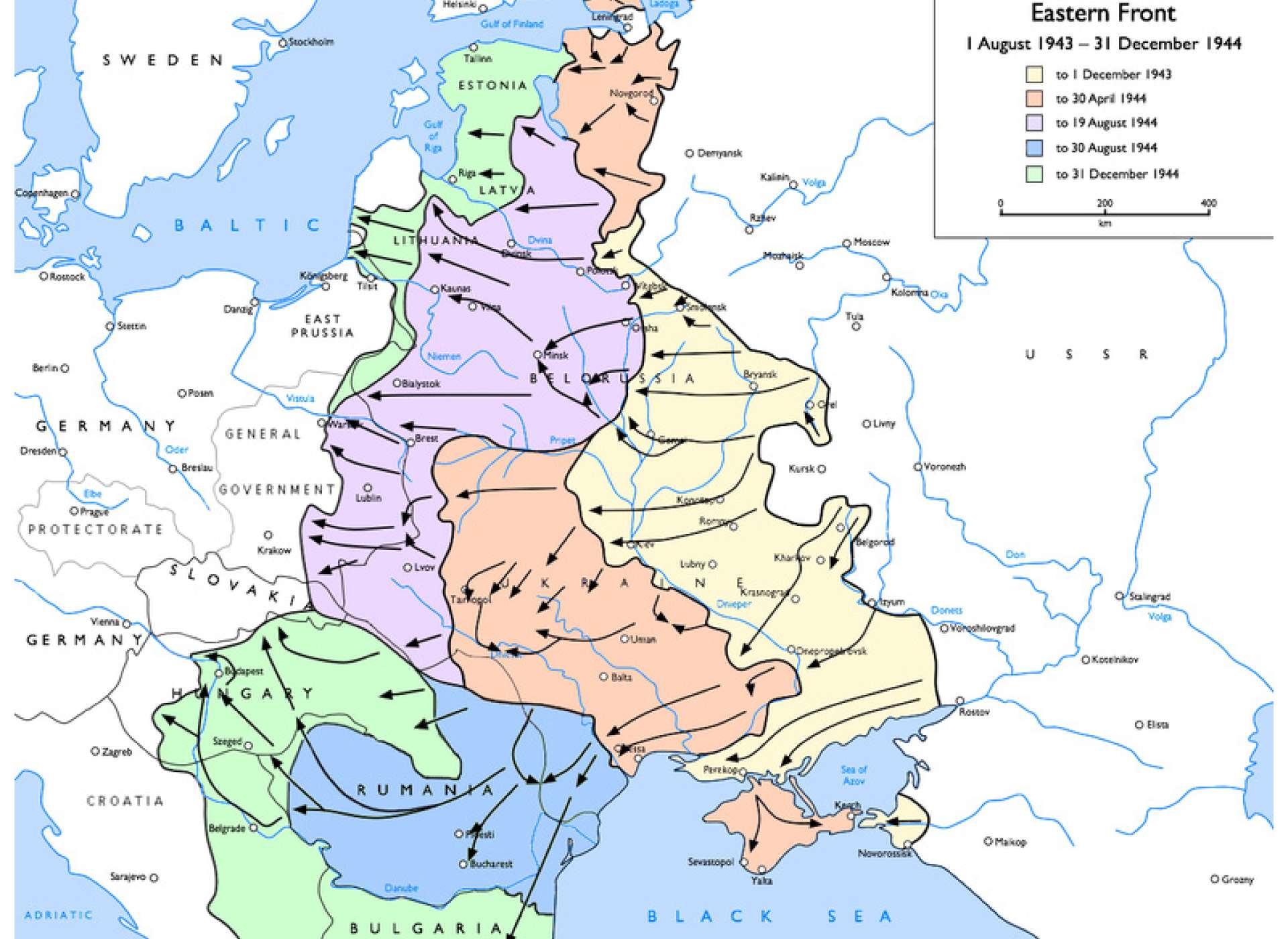
Map of Eastern Front August 1, 1943 - December 1944. Map courtesy of Wikimedia Commons, https://commons.wikimedia.org/wiki/File:Eastern_Front_1943-08_to_1944-12.png.
At the same time the AK was considering how to move forward with Operation Tempest, Stalin was planning to launch a major offensive against German Army Group Center in an attempt to thrust the Belorussian Front deep into central Poland and clear the way to Berlin. Stalin approved the final plan of attack against Army Group Center in Belorussia on May 31, 1944. Codenamed Operation Bagration after the Georgian field marshal Pyotr Bagration, who died defending Russia against Napoleon’s forces on the battlefield of Borodino in 1812, the plan fulfilled Stalin’s promise to Roosevelt and Churchill to launch an offensive on the eastern front in support of the planned Allied assault in France. Konstantin Rokossovsky, the Soviet commanding officer who masterminded the encirclement of the German Sixth Army at Stalingrad, was put in charge of the offensive and the stated military objective was to “destroy Army Group Center, liberate the Belorussian Soviet Republic, and then begin the liberation of fraternal Poland.”
Although Stalin planned to attack Army Group Center, the Germans expected the main thrust by the Red Army to occur further south, against Army Group North since the Red Army had so much success retaking territory across Ukraine and the Germans believed the Soviets wanted to capitalize on the political weakness of Germany’s allies. Therefore, part of Operation Bagration relied on maskirovka, “a clever and all-encompassing form of camouflage, misinformation, and deception” to draw German reserves to the south.
Since the plan required the movement of 1.7 million men in and around Belorussia in utter secrecy, no information about the upcoming attack was allowed to be leaked and correspondences, telephone conversations, and telegraph messages regarding preparations were forbidden. Moreover, front line soldiers were not allowed to know where they were being moved while the transportation of troops and equipment was kept out of sight of the general public. For example, 50,000 supply vehicles moved at night in complete darkness, vehicles were not allowed to use their headlights, artillery fire was prohibited, and officers had to dress as private soldiers.
Additionally, while the real front was secretly being prepared, the Soviets also constructed a “mock front” in Ukraine in an attempt to convince Hitler that the main summer offensive would be staged against Army Group North. To do so, Soviet air and rail activity in Ukraine increased, German reconnaissance flights were allowed to pass over front lines and photograph faux armies (which were actually rubber tanks and fake gun emplacements), radio traffic was faked, and a single army was moved back and forth every time German reconnaissance planes flew over to make it look like ten divisions had been assembled in the region.
The ploy worked. Hitler transported massive amounts of tank destroyers, battle tanks, assault guns, operational aircraft, and troops to the south.
On the eve of the attack, Army Group Center was left with only 1.2 million men in 63 divisions compared to 2.4 million Soviet troops in 168 divisions (more than 10 times the number of troops assembled for the invasion of Normandy), 12 tank corps, and 20 brigades. The Soviets also had the use of the newly formed 1st Polish Army, which was made up of 104,000 men, four divisions and two brigades. The 1st Polish Army was the second Polish army to be formed in the USSR during the war and was made up of Polish deportees, refugees, and POWs from Poland who found themselves in the Soviet Union and wanted to fight their way home. However, since approximately 43,000 of the soldiers were political prisoners who had been directly transferred from the Gulag, the army was subject to strict surveillance by Soviet-trained political commissars.
Operation Bagration was launched on June 23, 1944 and was an astonishing success. The operation had been set to begin on June 22, exactly three years after the German invasion of the Soviet Union but was delayed by one day. Nevertheless, the Soviet offensive caught the Germans by surprise and within hours entire formations including the 6th Corps’ 229th and 197th Infantry Division had ceased to exist. The German 53rd Corps was completely wiped out and 17,000 survivors were taken into captivity, while the 4th Luftwaffe Field Division was destroyed.
Rokossovsky’s attack from either side of the Berezina River converging on Minsk, the capital of Belorussia, began the following day and within a week a group of 100,000 German troops east of the city had been surrounded. Over half of the captured troops were taken to Moscow and paraded through Red Square. The Red Army continued its westward advance at an average pace of 10-15 km (6-10 miles) per day and by July 4 Army Group Center had lost 25 divisions.
Despite its initial failure, once the Soviets launched Operation Bagration, the AK decided to continue with Operation Tempest in order to assist the Red Army in retaking key Polish cities. However, unknown to AK leaders, Stalin sent a special order to all commanding officers on the Belorussian front stating:
“The Polish military detachments funded by the Polish émigré government have behaved suspiciously and have everywhere acted against the interests of the Red Army. When these formations are found, they must be immediately disarmed and sent to specially organized collection points for investigation.”
Consequently, as the NKVD followed the Red Army into new territory, they immediately disarmed and arrested any AK members they encountered, which only increased tensions between the Soviets and Poles.
One prime example of how the NKVD treated the AK occurred during the capture of Wilno. As the Red Army approached the city, the commander of the Home Army in Wilno, General Aleksander Krzyżanowski, set out plans for an uprising in the city, with the AK attacking German forces as they were evacuating their last key positions. Krzyżanowski assembled 10,000 troops near Wilno and, with the cooperation of the Red Army, which provided tanks, artillery, and air support, attacked the city from four directions.
The AK liberated the city on July 13 and celebrated the victory with the Red Army on July 15. Shortly thereafter, however, the NKVD moved in. Krzyżanowski and his officers were arrested and deported and about 6,000 AK members were ordered to assemble outside the city where the Soviets surrounded and disarmed them. Most were loaded on trains and deported to Kaluga, but several hundred who tried to escape were caught and killed. Arrests, deportation, and murder were common tactics employed by the NKVD against political enemies during the war, first during the Soviet occupation of the eastern part of Poland, of which the 1941 NKVD Prison Massacres in Western Ukraine are a prime example, and also as the Red Army retook Nazi held territory in 1944.
A similar incident occurred in Lwow at the end of July, where the AK started another uprising in which 4,000 AK troops captured the main railway station and took the large nineteenth century fortress, which was filled with German supplies. The same evening, the Soviet 10th Tank Corps entered the outskirts of the city and were joined by the 4th Guards Tank Army, which led to a German surrender a few days later. The Soviets congratulated the AK on the mutual victory, but soon disarmed, disbanded, and forced all Home Army troops to join the 1st Polish Army, led by General Zygmunt Berling.
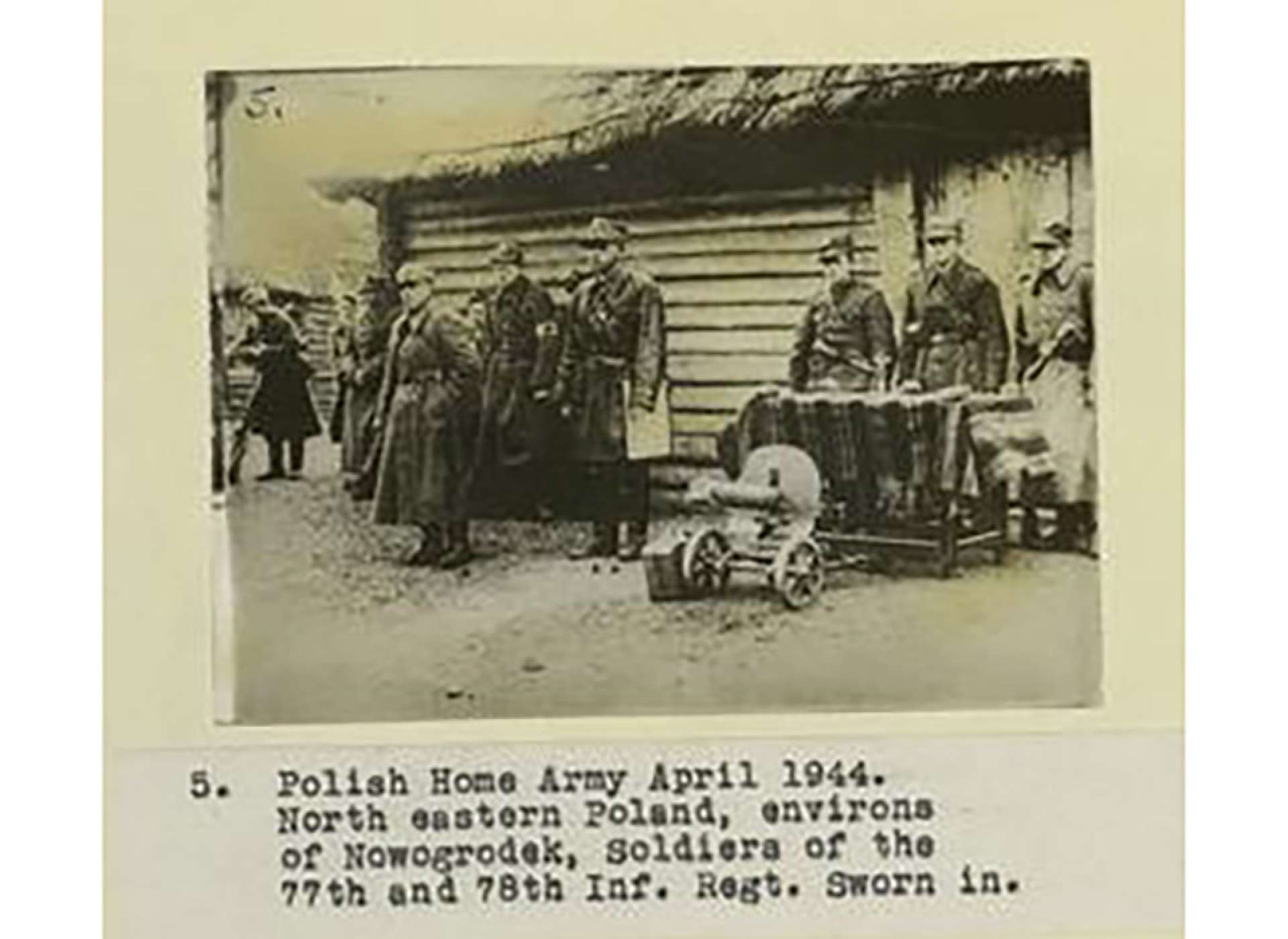
The Miriam and Ira D. Wallach Division of Art, Prints and Photographs: Photography Collection, The New York Public Library. “Two Photographs) Polish Home Army April 1944. North eastern Poland, environs of Nowogrodek, Soldiers of the 77th and 78th Inf. Regt. Sworn in. The heroic uprising of Warsaw. German photograph taken on August 30, 1944.” The New York Public Library Digital Collections. 1944. digitalcollections.nypl.org/items/510d47db-abd7-a3d9-e040-e00a18064a99
Despite the fact that Operation Tempest had assisted the Red Army in capturing Wilno, Lwow, Lublin and other smaller cities, Stalin did not allow the AK any kind of military or political victory. On July 31, Soviet officials invited about 30 senior AK officers to a conference where they were immediately arrested on the grounds of being “criminals” and “Polish fascists.” Although the exiled Polish leaders in London continued to regard themselves as the only legitimate Polish government, on July 22, a Soviet backed Committee of National Liberation was formed in Lublin, which Moscow recognized as the official national government of Poland. This made Stalin’s true intentions clear and put increasing pressure on the exiled Polish government and the AK as the Red Army approached Warsaw.
In light of these events, during the last week of July 1944, General Bór-Komorowski and other AK leaders began to convince themselves that the assumed proximity of the Red Army might give them the chance to include Warsaw in Operation Tempest. Both the exiled Polish government and the AK feared that if the AK did not act “the Soviets would liberate Warsaw and Stalin would broadcast to the world that the AK had been ineffective or had collaborated with the Nazis."
However, as Bór-Komorowski noted, the main problem with including Warsaw in Operation Tempest was that the AK had to run the great risk of undertaking open action without any coordination with the Red Army command.” Nonetheless, following a meeting with fellow AK officers on July 31, Bór-Komorowski decided to launch an uprising in Warsaw the next day. On August 1, 1944, the Warsaw Uprising began, and almost immediately the AK encountered a variety of problems.
The next two articles in this series will focus on the logistical and strategic problems facing the AK during the first weeks of the Warsaw Uprising, the lack of Allied support, and the increasing role civilians played in the uprising.
Jennifer Popowycz, PhD
Jennifer Popowycz, PhD is the Leventhal Research Fellow at The National WWII Museum. Her research focuses on the Eastern Front and Nazi occupation policies in Eastern Europe in World War II.
Cite this article:
MLA Citation:
APA Citation:
Chicago Style Citation:
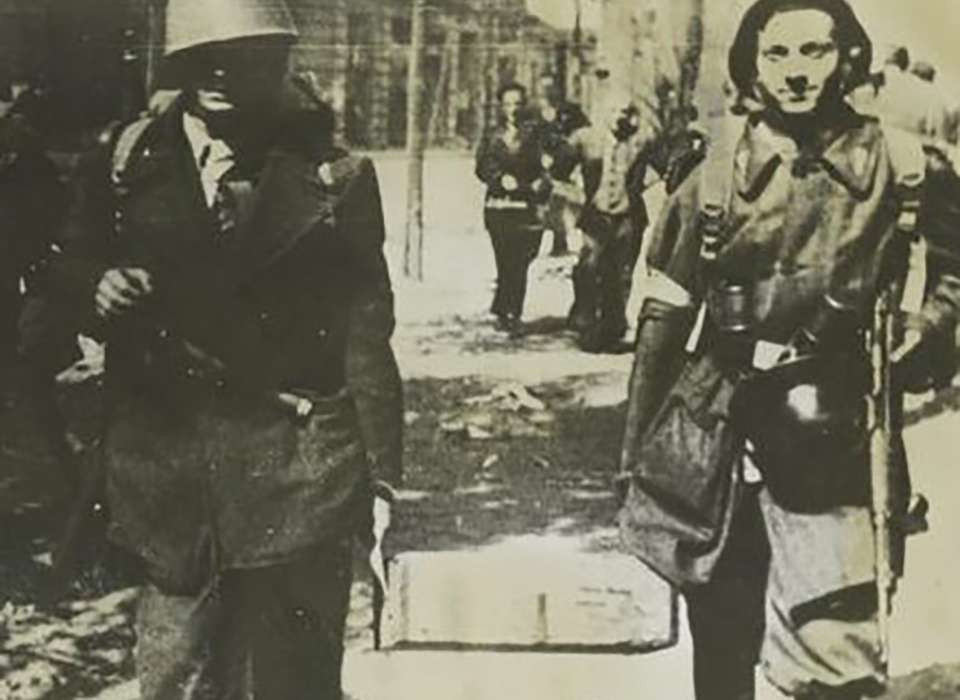

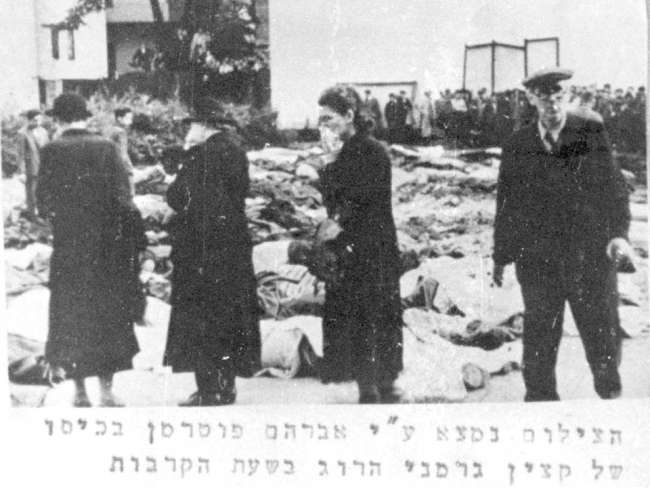
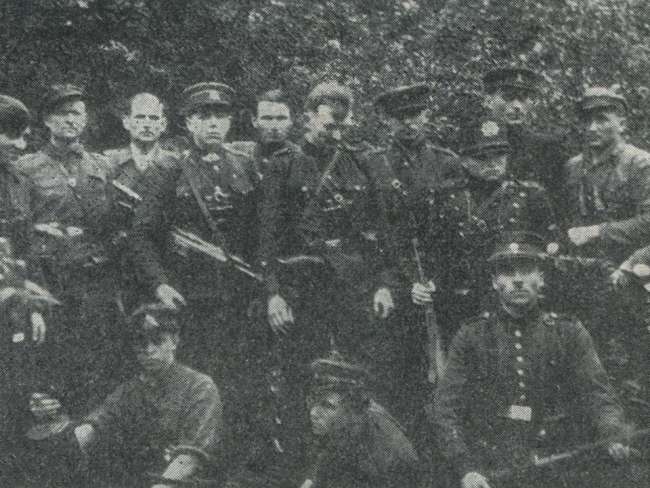



![Max Fuchs, New York City cantor, sings as Rabbi Sydney [sic] Lefkowitz, Richmond, VA, conducts the first Jewish services from Germany.](/sites/default/files/styles/max_650x650/public/2025-10/image1.jpg)



